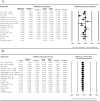Effect of statins on arterial wall inflammation as assessed by 18F-FDG PET CT: an updated systematic review and meta-analysis
- PMID: 39696570
- PMCID: PMC11658251
- DOI: 10.1186/s12950-024-00421-x
Effect of statins on arterial wall inflammation as assessed by 18F-FDG PET CT: an updated systematic review and meta-analysis
Abstract
Background: Pathogenesis of atherosclerosis is largely mediated by inflammatory process. Statins are lipid-lowering drugs which also have anti-inflammatory effects. 18 fluorine radiolabeled fluorodeoxyglucose (18 F-FDG) positron emission tomography-computed tomography (PET-CT) is considered to be a good indicator of arterial wall inflammation. Therefore, in this meta-analysis the role of statins on inflammatory process in the artery wall was evaluated using this method since its actual validity for this purpose is not yet well established.
Methods: PubMed, Scopus, Web of Science, ClinicalTrials.gov, and Google Scholar databases were searched using MESH terms and keywords. Funnel plot, Begg's rank correlation, and Egger's weighted regression tests evaluated publication bias in the meta-analysis. In cases where funnel plot asymmetry was observed, the "trim and fill" method was used to check the input of potentially missing studies.
Results: Findings of 10 clinical trials involving 373 subjects showed a remarkable reduction of arterial wall 18 F-FDG uptake according to target-to-background ratio (TBR) index after treatment with statins. Subgroup analysis showed a significant decrease in TBR with high-intensity and non-significant reduction of TBR with low-to-moderate-intensity statin therapy.
Conclusion: Treatment with statins suppressed arterial wall inflammation as shown by using 18 F-FDG PET-CT.
Keywords: 18F-FDG PET-CT; Atherosclerosis; Cardiovascular disease; Inflammation; Statins.
© 2024. The Author(s).
Conflict of interest statement
Declarations. Ethical approval: Not applicable. Consent to participate: Not applicable. Consent for publication: Not applicable. Competing interests: The authors declare no competing interests.
Figures






Similar articles
-
Effect of Statin Therapy on Arterial Wall Inflammation Based on 18F-FDG PET/CT: A Systematic Review and Meta-Analysis of Interventional Studies.J Clin Med. 2019 Jan 18;8(1):118. doi: 10.3390/jcm8010118. J Clin Med. 2019. PMID: 30669380 Free PMC article. Review.
-
The Effects of Statin Dose, Lipophilicity, and Combination of Statins plus Ezetimibe on Circulating Oxidized Low-Density Lipoprotein Levels: A Systematic Review and Meta-Analysis of Randomized Controlled Trials.Mediators Inflamm. 2021 Sep 4;2021:9661752. doi: 10.1155/2021/9661752. eCollection 2021. Mediators Inflamm. 2021. PMID: 34526854 Free PMC article.
-
A pilot trial to examine the effect of high-dose niacin on arterial wall inflammation using fluorodeoxyglucose positron emission tomography.Acad Radiol. 2015 May;22(5):600-9. doi: 10.1016/j.acra.2014.12.015. Epub 2015 Feb 21. Acad Radiol. 2015. PMID: 25708866 Clinical Trial.
-
Time-related aortic inflammatory response, as assessed with 18F-FDG PET/CT, in patients hospitalized with severely or critical COVID-19: the COVAIR study.J Nucl Cardiol. 2023 Feb;30(1):74-82. doi: 10.1007/s12350-022-02962-1. Epub 2022 May 2. J Nucl Cardiol. 2023. PMID: 35501458 Free PMC article.
-
Time-Related Vascular Inflammatory Response to COVID-19 Assessed by 18F-FDG PET/CT in Follow-Up Tumor Patients.J Inflamm Res. 2023 Jul 24;16:3109-3117. doi: 10.2147/JIR.S415288. eCollection 2023. J Inflamm Res. 2023. PMID: 37520665 Free PMC article.
References
-
- Reiner Ž. Statins in the primary prevention of cardiovascular disease. Nat Reviews Cardiol. 2013;10(8):453–64. - PubMed
-
- Salami JA, et al. National trends in statin use and expenditures in the US adult population from 2002 to 2013: insights from the medical expenditure panel survey. JAMA Cardiol. 2017;2(1):56–65. - PubMed
LinkOut - more resources
Full Text Sources

